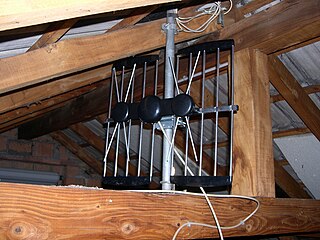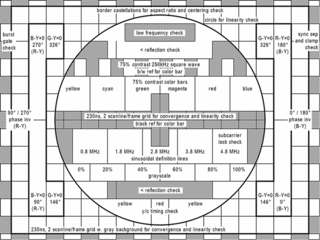Related Research Articles

Microwaves are a form of electromagnetic radiation with wavelengths ranging from about one meter to one millimeter; with frequencies between 300 MHz (1 m) and 300 GHz (1 mm). Different sources define different frequency ranges as microwaves; the above broad definition includes both UHF and EHF bands. A more common definition in radio engineering is the range between 1 and 100 GHz. In all cases, microwaves include the entire SHF band at minimum. Frequencies in the microwave range are often referred to by their IEEE radar band designations: S, C, X, Ku, K, or Ka band, or by similar NATO or EU designations.
In telecommunications, orthogonal frequency-division multiplexing (OFDM) is a method of encoding digital data on multiple carrier frequencies. OFDM has developed into a popular scheme for wideband digital communication, used in applications such as digital television and audio broadcasting, DSL internet access, wireless networks, power line networks, and 4G mobile communications.
The Ku band is the portion of the electromagnetic spectrum in the microwave range of frequencies from 12 to 18 gigahertz (GHz). The symbol is short for "K-under", because it is the lower part of the original NATO K band, which was split into three bands because of the presence of the atmospheric water vapor resonance peak at 22.24 GHz, (1.35 cm) which made the center unusable for long range transmission. In radar applications, it ranges from 12-18 GHz according to the formal definition of radar frequency band nomenclature in IEEE Standard 521-2002.

In communications and electronic engineering, an intermediate frequency (IF) is a frequency to which a carrier wave is shifted as an intermediate step in transmission or reception. The intermediate frequency is created by mixing the carrier signal with a local oscillator signal in a process called heterodyning, resulting in a signal at the difference or beat frequency. Intermediate frequencies are used in superheterodyne radio receivers, in which an incoming signal is shifted to an IF for amplification before final detection is done.

Digital Video Broadcasting (DVB) is a set of international open standards for digital television. DVB standards are maintained by the DVB Project, an international industry consortium, and are published by a Joint Technical Committee (JTC) of the European Telecommunications Standards Institute (ETSI), European Committee for Electrotechnical Standardization (CENELEC) and European Broadcasting Union (EBU).

Ultra high frequency (UHF) is the ITU designation for radio frequencies in the range between 300 megahertz (MHz) and 3 gigahertz (GHz), also known as the decimetre band as the wavelengths range from one meter to one tenth of a meter. Radio waves with frequencies above the UHF band fall into the super-high frequency (SHF) or microwave frequency range. Lower frequency signals fall into the VHF or lower bands. UHF radio waves propagate mainly by line of sight; they are blocked by hills and large buildings although the transmission through building walls is strong enough for indoor reception. They are used for television broadcasting, cell phones, satellite communication including GPS, personal radio services including Wi-Fi and Bluetooth, walkie-talkies, cordless phones, and numerous other applications.

Multichannel Multipoint Distribution Service (MMDS), formerly known as Broadband Radio Service (BRS) and also known as Wireless Cable, is a wireless telecommunications technology, used for general-purpose broadband networking or, more commonly, as an alternative method of cable television programming reception.

Amateur television (ATV) is the transmission of broadcast quality video and audio over the wide range of frequencies of radio waves allocated for radio amateur (Ham) use. ATV is used for non-commercial experimentation, pleasure, and public service events. Ham TV stations were on the air in many cities before commercial television stations came on the air. Various transmission standards are used, these include the broadcast transmission standards of NTSC in North America and Japan, and PAL or SECAM elsewhere, utilizing the full refresh rates of those standards. ATV includes the study of building of such transmitters and receivers, and the study of radio propagation of signals travelling between transmitting and receiving stations.
The S band is a designation by the Institute of Electrical and Electronics Engineers (IEEE) for a part of the microwave band of the electromagnetic spectrum covering frequencies from 2 to 4 gigahertz (GHz). Thus it crosses the conventional boundary between the UHF and SHF bands at 3.0 GHz. The S band is used by airport surveillance radar for air traffic control, weather radar, surface ship radar, and some communications satellites, especially those used by NASA to communicate with the Space Shuttle and the International Space Station. The 10 cm radar short-band ranges roughly from 1.55 to 5.2 GHz. The S band also contains the 2.4–2.483 GHz ISM band, widely used for low power unlicensed microwave devices such as cordless phones, wireless headphones (Bluetooth), wireless networking (WiFi), garage door openers, keyless vehicle locks, baby monitors as well as for medical diathermy machines and microwave ovens. India’s regional satellite navigation network (IRNSS) broadcasts on 2.483778 to 2.500278 GHz.
The X band is the designation for a band of frequencies in the microwave radio region of the electromagnetic spectrum. In some cases, such as in communication engineering, the frequency range of the X band is rather indefinitely set at approximately 7.0 to 11.2 GHz. In radar engineering, the frequency range is specified by the IEEE at 8.0 to 12.0 GHz. The X band is used for radar, satellite communication, and wireless computer networks.
The V band ("vee-band") is a standard designation by the Institute of Electrical and Electronic Engineers (IEEE) for a band of frequencies in the microwave portion of the electromagnetic spectrum ranging from 40 to 75 gigahertz (GHz). The V band is not heavily used, except for millimeter wave radar research and other kinds of scientific research. It should not be confused with the 600–1000 MHz range of Band V of the UHF frequency range.
Free-to-air (FTA) are television (TV) and radio services broadcast in clear (unencrypted) form, allowing any person with the appropriate receiving equipment to receive the signal and view or listen to the content without requiring a subscription, other ongoing cost or one-off fee. In the traditional sense, this is carried on terrestrial radio signals and received with an antenna.

Digital Video Broadcasting - Satellite - Second Generation (DVB-S2) is a digital television broadcast standard that has been designed as a successor for the popular DVB-S system. It was developed in 2003 by the DVB Project, an international industry consortium, and ratified by ETSI in March 2005. The standard is based on, and improves upon DVB-S and the electronic news-gathering system, used by mobile units for sending sounds and images from remote locations worldwide back to their home television stations.

B-MAC is a form of analog video encoding, specifically a type of (Multiplexed Analogue Components encoding. MAC encoding was designed in the mid 80s for use with Direct Broadcast Satellite systems. Other analog video encoding systems include NTSC, PAL and SECAM. Unlike the FDM method used in those, MAC encoding uses a TDM method. B-MAC was a proprietary MAC encoding used by Scientific-Atlanta for encrypting broadcast video services; the full name was "Multiple Analogue Component, Type B".
Satellite television is a service that delivers television programming to viewers by relaying it from a communications satellite orbiting the Earth directly to the viewer's location. The signals are received via an outdoor parabolic antenna commonly referred to as a satellite dish and a low-noise block downconverter.
DVB-SH is a physical layer standard for delivering IP based media content and data to handheld terminals such as mobile phones or PDAs, based on a hybrid satellite/terrestrial downlink and for example a GPRS uplink. The DVB Project published the DVB-SH standard in February 2007.
China Mobile Multimedia Broadcasting (CMMB) is a mobile television and multimedia standard developed and specified in China by the State Administration of Radio, Film, and Television (SARFT). It is based on the Satellite and Terrestrial Interactive Multiservice Infrastructure (STiMi), developed by TiMiTech, a company formed by the Chinese Academy of Broadcasting Science. Announced in October 2006, it has been described as being similar to Europe's DVB-SH standard for digital video broadcast from both satellites and terrestrial repeaters to handheld devices.
Saorsat is a free-to-air satellite service in Ireland. The service launched on 3 May 2012.

The C band is a designation by the Institute of Electrical and Electronics Engineers (IEEE) for a portion of the electromagnetic spectrum in the microwave range of frequencies ranging from 4.0 to 8.0 gigahertz (GHz); however, this definition is the one used by radar manufacturers and users, not necessarily by microwave radio telecommunications users. The C band is used for many satellite communications transmissions, some Wi-Fi devices, some cordless telephones as well as some surveillance and weather radar systems.
References
- ↑ telecomabc.com - DVB-MS and DVB-MC, read 2012-08-23